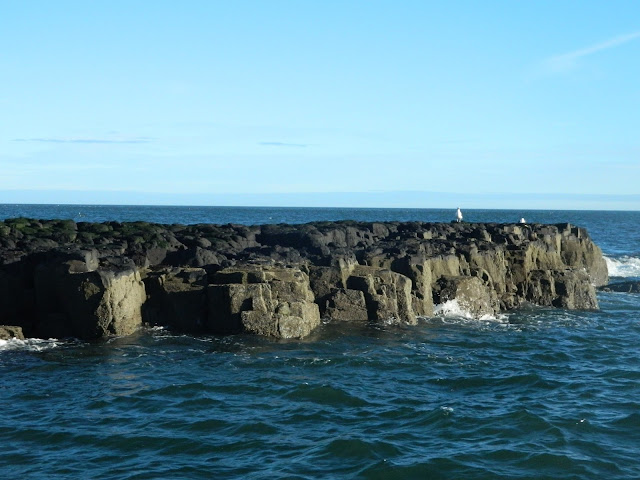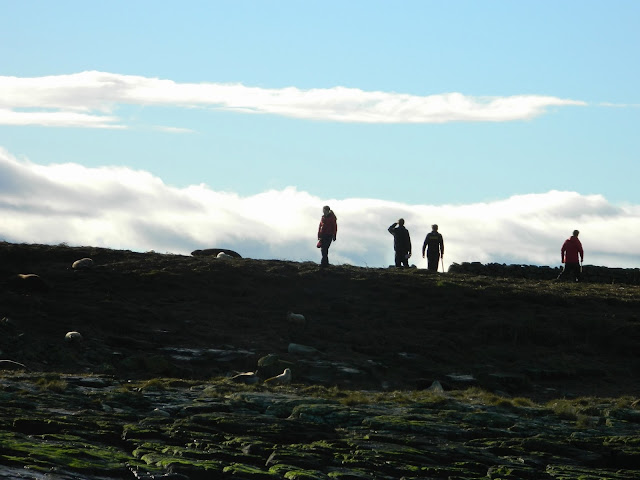Farne Islands
The Farne Islands lie two to three miles off the Northumberland coast midway between the fishing village of Seahouses and the magnificent Castle of Bamburgh. As well as being the most famous Sea Bird Sanctuary
in the British Isles they also have a large colony of Atlantic or Grey Seals.
Staple Island is a rocky island and as such is not recommended for disabled visitors.
It is also an island which is very exposed to the elements which means landing can occasionally
be difficult. It is always advisable to ask about the weather and sea conditions before sailing.
Landings however are always made at the skippers discretion.
This is an Island noted for its vast seabird colonies, especially those of the Auk family such as Guillemots, Razorbills and Puffins. Puffins are the most numerous birds that nest on the Farnes with over 10,000 pairs nesting on Staple Island alone! A footpath over the top of the Island takes you straight through the nesting Puffins.
"The Pinnacles" are isolated rock stacks situated off Staple Island, and the cliff faces offer the perfect opportunity to see these birds in their natural habitat. Staple Island is an ornithologist's and photographer's dream and for anybody who wants to get close to these birds it's an experience they'll definitely take home with them.
This is an Island noted for its vast seabird colonies, especially those of the Auk family such as Guillemots, Razorbills and Puffins. Puffins are the most numerous birds that nest on the Farnes with over 10,000 pairs nesting on Staple Island alone! A footpath over the top of the Island takes you straight through the nesting Puffins.
"The Pinnacles" are isolated rock stacks situated off Staple Island, and the cliff faces offer the perfect opportunity to see these birds in their natural habitat. Staple Island is an ornithologist's and photographer's dream and for anybody who wants to get close to these birds it's an experience they'll definitely take home with them.

| At 16 acres, Inner Farne is the largest of the Farne Islands and in the Summer months it becomes home to many thousands of nesting seabirds. These birds include Puffins, Guillemots, Razorbills, Sandwich Terns, Common Terns, Roseate Terns, Arctic Terns, Shags, Cormorants and Eider Ducks. In the year 678 Inner Farne was also home to St Cuthbert. After 12 years as Prior of Lindisfarne, St.Cuthbert retired to Inner Farne until he became Bishop of Lindisfarne in 684. He returned to Inner Farne when his health deteriorated and died there on 20th March 687. A church was built on the island in 1370 dedicated to St Cuthbert and is open to the public today. Apart from the Inner Farne Lighthouse, all the buildings on the island date from the monastic period. The "Fishehouse" situated beside the landing jetty is all that remains of the Guest House which was built by St Cuthbert for his visitors. In 1540 a Prior named Castell built the "Pele Tower" to house the monks who lived on the island. The Tower is now home to the National Trust Rangers who live there for 9 months of the year to look after the Island and its' wildlife. |
I couldn't resist to share this video here, you will see why!
Preston Tower
The Preston pele tower, which is owned by GJ Baker Cresswell, was built between 1392 and 1399, when warfare between England and Scotland was endemic. At the time of Agincourt (1415) it was one of 78 Pele Towers in Northumberland. Its owners included Sir Guiscard Harbottle, who was slain fighting against James IV at the battle of Flodden in 1513, the conflict that brought Mary, Queen of Scots to the Scottish throne.
Sir Nikolaus Pevsner, the famous architectural historian, described Preston Tower as ‘amongst the most spectacular pieces of medieval masonry in England’. The large stone blocks used in its 7-foot-thick walls bear the same masons’ marks as those at Warkworth Castle, further down the coast.
On the ground floor you can visit the guard room and prison, while the first floor has a bedroom and living room, furnished as they might have been around 1400. On the second floor is the Flodden room, with a description of the battle of Flodden, and some interesting extracts from Border history and the Border ballads. The second floor also houses the clock mechanism.
The views from the top of the tower are spectacular, and one can imagine what it was like to be dropping unpleasant objects onto the attackers below.
On the ground floor you can visit the guard room and prison, while the first floor has a bedroom and living room, furnished as they might have been around 1400. On the second floor is the Flodden room, with a description of the battle of Flodden, and some interesting extracts from Border history and the Border ballads. The second floor also houses the clock mechanism.
The views from the top of the tower are spectacular, and one can imagine what it was like to be dropping unpleasant objects onto the attackers below.
In 1864 a magnificent striking clock was installed in the
centre of the tower, with faces on both the front and rear walls.
The flat-bed mechanism of the clock, an innovation introduced only a few years before, is similar to that used for Big Ben, and is open to view on the second floor of the tower. The clock and bell strike are powered by two large stone weights.
The clock strikes the hour on a bell weighing 1100 lbs (about 500 kg),
The clock strikes the hour on a bell weighing 1100 lbs (about 500 kg),
which is housed in one of the turrets.




































































































